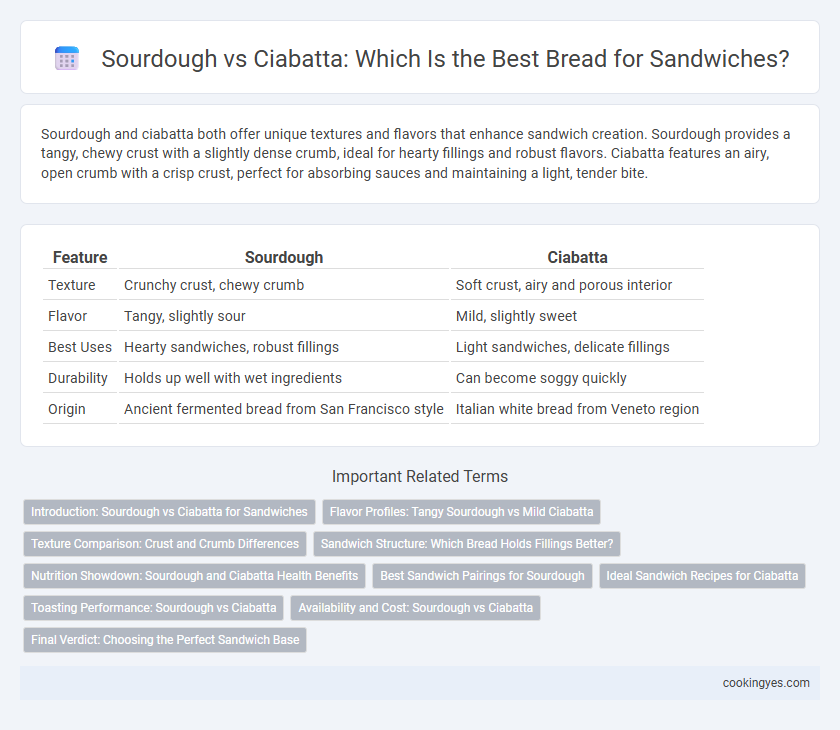Sourdough and ciabatta both offer unique textures and flavors that enhance sandwich creation. Sourdough provides a tangy, chewy crust with a slightly dense crumb, ideal for hearty fillings and robust flavors. Ciabatta features an airy, open crumb with a crisp crust, perfect for absorbing sauces and maintaining a light, tender bite.
Table of Comparison
| Feature | Sourdough | Ciabatta |
|---|---|---|
| Texture | Crunchy crust, chewy crumb | Soft crust, airy and porous interior |
| Flavor | Tangy, slightly sour | Mild, slightly sweet |
| Best Uses | Hearty sandwiches, robust fillings | Light sandwiches, delicate fillings |
| Durability | Holds up well with wet ingredients | Can become soggy quickly |
| Origin | Ancient fermented bread from San Francisco style | Italian white bread from Veneto region |
Introduction: Sourdough vs Ciabatta for Sandwiches
Sourdough and ciabatta offer distinct textures and flavors, making them popular choices for sandwich bases. Sourdough features a tangy, robust taste with a chewy crust, ideal for hearty fillings like roast beef or smoked turkey. Ciabatta provides a lighter, airier crumb with a crisp crust, complementing fresh vegetables and deli meats in gourmet sandwich creations.
Flavor Profiles: Tangy Sourdough vs Mild Ciabatta
Sourdough bread offers a distinctive tangy flavor derived from its natural fermentation process, creating a complex and slightly sour taste that enhances savory sandwich fillings. Ciabatta features a mild, slightly sweet flavor with a light, airy crumb and a crispy crust, providing a neutral base that complements a wide range of ingredients without overpowering them. Choosing between sourdough and ciabatta depends on whether you prefer a bold, tangy flavor or a subtle, mild taste to balance your sandwich components.
Texture Comparison: Crust and Crumb Differences
Sourdough features a thick, crunchy crust with an open, chewy crumb that provides a rustic texture ideal for hearty sandwiches. Ciabatta offers a thin, crispy crust and a light, airy crumb characterized by large holes, creating a delicate texture perfect for lighter sandwiches. The dense, tangy interior of sourdough contrasts with ciabatta's soft, elastic crumb, influencing the overall mouthfeel and sandwich structure.
Sandwich Structure: Which Bread Holds Fillings Better?
Sourdough's dense crumb and thicker crust provide a sturdy sandwich base that holds fillings firmly, minimizing sogginess and spillage. Ciabatta's open crumb and airy texture offer a lighter bite but can struggle to contain juicy or heavy ingredients without becoming soggy. For structurally sound sandwiches, sourdough typically delivers better support and durability to maintain filling integrity.
Nutrition Showdown: Sourdough and Ciabatta Health Benefits
Sourdough bread offers a rich source of probiotics and lower glycemic index due to its natural fermentation process, aiding digestion and blood sugar control. Ciabatta provides a lighter texture with slightly higher carbohydrate content, supplying quick energy, but it lacks the probiotic benefits of sourdough. Both breads deliver essential nutrients like iron and B vitamins, making them nutritious options, yet sourdough's fermentation enhances nutrient absorption and gut health.
Best Sandwich Pairings for Sourdough
Sourdough bread, with its tangy flavor and chewy texture, pairs exceptionally well with rich and savory sandwich fillings like smoked turkey, sharp cheddar, and roasted vegetables, enhancing each bite's complexity. Its sturdy crust and slightly sour taste complement ingredients such as avocado, cured meats, and creamy spreads, balancing moisture and flavor without becoming soggy. Ideal for gourmet sandwiches, sourdough acts as a flavorful base that holds up well to bold flavors and hearty toppings.
Ideal Sandwich Recipes for Ciabatta
Ciabatta offers a light, airy crumb with a slightly crisp crust, making it an ideal sandwich base that absorbs flavors without becoming soggy. Its open texture complements hearty fillings like roasted vegetables, Italian cold cuts, or mozzarella with sun-dried tomatoes. Perfect for paninis or cold sandwiches, ciabatta enhances both rustic and gourmet recipes with its balanced taste and firm structure.
Toasting Performance: Sourdough vs Ciabatta
Sourdough offers a robust toasting performance with its thick, chewy crust and dense crumb, creating a crispy exterior while maintaining a slightly tangy and tender interior. Ciabatta toasts quickly and evenly due to its open, airy structure and thin crust, producing a light, crunchy bite without becoming overly hard. For sandwiches requiring sturdy support and a complex flavor profile after toasting, sourdough is ideal, while ciabatta is perfect for those preferring a crisp texture with a delicate, porous crumb.
Availability and Cost: Sourdough vs Ciabatta
Sourdough bread is widely available in most supermarkets and artisan bakeries, often priced moderately due to its popularity and traditional fermentation process. Ciabatta tends to be slightly more expensive and less commonly stocked outside specialty or Italian bakeries, reflecting its artisanal baking method and regional origin. Both breads offer unique textures for sandwiches, but sourdough provides a more cost-effective and accessible option for everyday use.
Final Verdict: Choosing the Perfect Sandwich Base
Sourdough offers a tangy flavor and sturdy texture that holds up well against moist and hearty fillings, enhancing the overall sandwich experience. Ciabatta provides a light, airy crumb and a crisp crust, making it ideal for sandwiches where a softer bite complements ingredients like fresh vegetables and deli meats. Choosing between sourdough and ciabatta depends on the desired sandwich profile, with sourdough lending boldness and durability, while ciabatta emphasizes a delicate balance of softness and crunch.
Sourdough vs ciabatta for sandwich base Infographic

 cookingyes.com
cookingyes.com